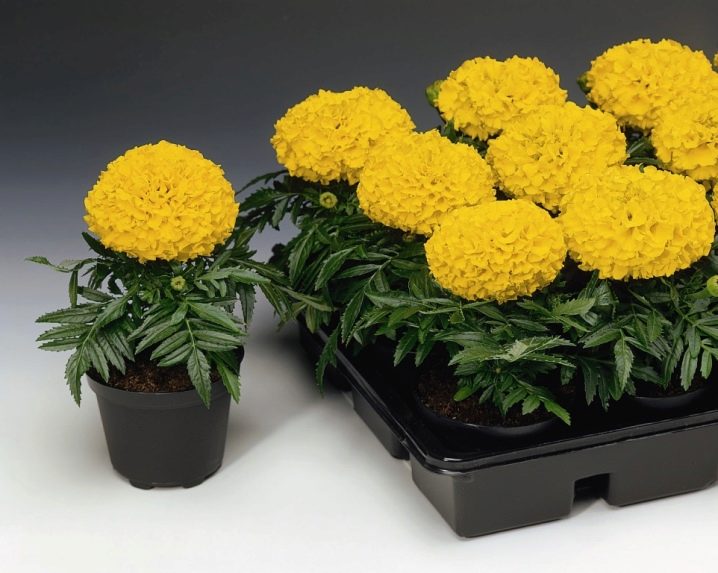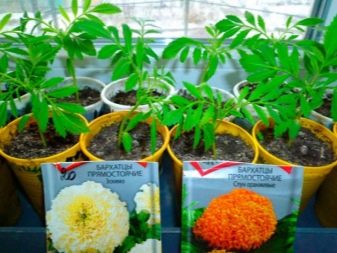Marigolds "Antigua": description of the variety and its varieties, cultivation features

Marigolds from the Astrov family are considered very popular representatives of horticultural crops. The natural habitat of flowers is South America. There they still act as wild plants. To date, breeders have already bred more than 50 varieties. Antigua marigolds are one of the most popular varieties of all the species. A characteristic feature is large double flowers. The plant is considered very popular and almost irreplaceable in landscape design. Marigolds always serve as the basis for any composition in the garden.


Description
Marigolds have the international name "tagétes" (lat. Tagétes). These plants are able to quickly adapt to climate change. The flower owes this ability to its root system, which is very well developed. Also, the stem, which has a high level of strength, helps the flowers to quickly reorganize to changes in climatic conditions.
- Height of bush plantings plants can reach a maximum of 2 meters.
- The leaf shape of marigolds is pinnately-divided. They are painted in a rich green hue. Sometimes there are representatives of this species with whole leaves.
- The flowers are golden, yellow and brown. The petals of the plant are very similar to velvet to the touch.
- The plant is distinguished by its ability to bloom for a long time. Usually this process occurs at the beginning of summer and lasts until the end of the autumn season.
- An easy way to reproduce. One plant is capable of producing a large number of seeds.
- Life span can be up to 4 years old.


If we talk about the Antigua marigold variety, it is worth emphasizing that the plant is considered dwarf, its maximum height is 30 centimeters. The leaves of flowers are elongated, and their edging consists of small teeth. They are painted green. The leaves are attached to the stem with a petiole. The flower basket is terry, and it is painted in yellow or golden shades.
Flowers can usually be 10 centimeters in diameter. Tagetes bloom can last up to 2 weeks. If you cleanse the plant from the buds that have withered in time, you can prolong the flowering process.
In order for the buds to grow larger, it is recommended to plant marigolds in well-lit places.

Varieties
The breeders did a great job with this type of plant, they managed to bring out more than fifty varieties of Tagetes. There are 3 of the most common marigold varieties.
- Erect (African). Representatives of this culture differ from the rest in their large size, their height can reach 100 centimeters. Their terry inflorescences are considered the largest (up to 15 centimeters), and the color is mostly monophonic.

- Rejected (French). Often such marigolds are called spreading. The height of the bushes does not differ in its scale, their maximum is 60 centimeters. A large number of flowers bloom on the bushes, and their color palette is very diverse. The diameter of the inflorescences (double and non-double) can reach 8 centimeters.

- Thin-leaved (Mexican). The plant is distinguished by its luxurious appearance, which is created by branched shoots. The height of marigolds can vary from 20 to 40 centimeters.The shape is spherical, the leaves are not large, and the inflorescences can reach 3 centimeters in diameter.

There are also hybrid varieties of the Antigua variety.
- Antigua F1 Primrose. The bushes of this plant are characterized by a compact size, in height it can reach 30 centimeters. Refers to erect representatives of culture. The buds, collected in inflorescences, can usually be 9 centimeters in diameter. Flowers are painted in lemon color. This variety blooms before the onset of cold weather.

- Antigua Orange... It is a representative of undersized Tagetes. This is a very popular option among flower growers, due to the contrasting color of the inflorescences. The buds are large enough and can reach 10 centimeters, densely double inflorescences. The shape of the plant bushes resembles a sphere.

- Antigua Gold. The bushes of such marigolds are in the shape of a ball, directly proportional in height and width (about 30 centimeters). The flowers are yellow. The bud size can be 8 centimeters. Quite unpretentious in care. Differs in a long flowering nature.

- Antigua Mix. The branches of the hybrid are basal. Plant height does not exceed 30 centimeters. A distinctive feature is the uniformity of habit. The inflorescences have bright shades. It is characterized by high resistance to bad weather.

- Antigua Ellou. It is a stunted plant, its height reaches 25 centimeters on average. Densely double flowers are 10 centimeters in diameter. The petals are bright yellow.

Growing features
As a rule, there are no special difficulties in the process of growing marigolds. The basis for intensive growth is fertile soil and good lighting. You can fertilize the selected place using peat. If there is a lack of nutrients on the site, it is recommended to use fertilizers. Usually fertilizing is carried out with fertilizers based on phosphorus. It is especially important to use this recommendation during the flowering period of marigolds. The earth needs to be loosened from time to time, this will contribute to oxygenation of the root system. Although tagetes is distinguished by its drought tolerance, it still needs watering.
Regular moisture saturation during the growing season will contribute to the formation of massive stems and luxurious inflorescences.


Like many other ornamental plants, marigolds can be planted in two ways.
Seed planting
In this case, the seeds are planted in the ground without specific preparatory steps. Sowing marigolds is recommended in mid-May. It is necessary to dig a ditch, the depth of which should not exceed 5 centimeters. After the prepared soil, it is necessary to water and sow seeds. The sown soil is covered with earth. Plant shoots appear only if they are densely planted. In order for the shoots to appear earlier, it is recommended to moisten the seeds a few days before sowing.


Planting seedlings
This method allows you to achieve flowering at an earlier date. Seeds should be sown in early spring in a small container. This method does not require a lot of effort. It is worth considering which variety the marigolds belong to in order to correctly determine the sowing time. Erect tagetes are recommended to be planted at the very beginning of spring, but undersized ones are planted a month later. Before planting seeds for seedlings, it is necessary to prepare a mixture for soil in a 1: 1 ratio. Peat, turf, sand and humus should be mixed.


It is recommended to treat the soil with a manganese solution. In order to avoid stagnation of water in the soil, the first layer in the tank is formed from the drainage. It is necessary to plant seeds from each other at a distance of at least 2 centimeters. The best way to water the plant is using a spray bottle. The temperature should be about 25 degrees. When the first shoots appear, the flowers are rearranged to a cooler place, but the illumination should be at the same level.The main thing is that the temperature changes by no more than 10 degrees. Otherwise, the growth of marigolds may slow down, and flowering will stop altogether. Pinching tagetes is strongly discouraged. Such actions can provoke late flowering.


Care rules
Antigua is representative of a culture that can thrive in all conditions. To ensure the plant looks beautiful and blooms for a long time, it is recommended to adhere to some basic rules.
- Good lighting. Marigolds need to get plenty of heat. Shaded areas should not be used for planting Tagetes. Shade is not a big problem for the plant, but growth and flowering slows down under these conditions.
- Watering. During the period of intensive development of Tagetes, it is necessary to carry out abundant watering. During the first 30 days, it is recommended to water the plant every other day. When buds begin to form, you need to reduce watering. This is necessary to avoid stagnant water. As you know, this can cause diseases of the root system.
- Top dressing. When the first shoots appear, start fertilizing the marigolds. The plant does not require mandatory feeding, it is necessary for more intense flowering of the bushes. Complex fertilizers are perfect for this mission. After more than 10 flowers appear on the tagetes, you can re-fertilize the plant.
- Pests and diseases. Marigolds are very resistant to various diseases and pests. The thing is that the petals of the buds are saturated with a specific smell, which serves as a protection for the plant. High humidity levels can be harmful to it. In this case, snails appear on the marigolds. In addition, slugs are also a danger to the plant. Bleach will help get rid of pests. The jar with the substance must be placed at an acceptable distance from the flowers.
- Storage. After the plants have faded, you need to loosen the soil. Dried buds, if any, must be removed. For the winter, the bushes are covered with foil. Foliage can also be used in some cases.
The process of caring for flowers will not take much time and effort, and beautiful and healthy marigolds will delight you with their appearance and delight guests every day.


Sowing marigolds for seedlings with sprouted seeds - how to do this, see the video.







































































































The comment was sent successfully.